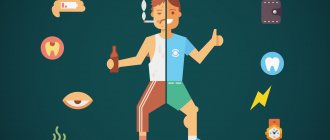But this is so! What is a habit?
A habit is an automatically reproduced action, the execution of which is initiated by some signal (habit trigger), performed and completed with a feeling of pleasure. ("Wikipedia")
What's the most important thing here? Let's note three points:
- Automatically reproduced action - that is, we do not think about what and how we do, everything happens “by itself”;
- Initiated by a habit trigger, in other words, as soon as a situation arises that is suitable for the trigger, it works on its own;
- Ends with a feeling of pleasure. That is, any habit brings us at least a little joy, satisfaction, some kind of positive.
What is a habit and how does it affect our life?
From the point of view of neurophysiology, a habit is a formed chain of neural connections in the brain. This chain allows you to make decisions faster and act without thinking. This makes it possible to significantly save time.
In the primitive world, this function was aimed at survival; it shaped human behavior depending on the circumstances. Time passes, but the essence does not change. Habit still actively influences our behavior in similar situations.
Probably everyone has noticed that in a stressful situation people tend to reproduce certain patterns. For example, someone starts smoking to calm down.
Our lifestyle is a set of habits that we reproduce every day. The quality of our life depends on the quality of our habits. So, if a person has more positive habits, then he will “grow”. If there are more bad habits, then its growth may be hampered. Let's figure out what categories habits are divided into and what their impact is.
Ways to overcome complexes
Everyone has their own path of development and improvement. The ways of overcoming complexes and solving problems aimed primarily at preserving one’s physical and psychological health, thereby benefiting the people around us and our Earth, are also individual. The following can help in the fight against bad habits:
1. Maintaining mutual respect, love, psychological comfort in the family.
2. Communication with people who are ready to support you on the path of self-development.
Best materials of the month
- Coronaviruses: SARS-CoV-2 (COVID-19)
- Antibiotics for the prevention and treatment of COVID-19: how effective are they?
- The most common "office" diseases
- Does vodka kill coronavirus?
- How to stay alive on our roads?
3. Taking care of physical health: quality nutrition, sleep, activity.
4. Favorite activity, hobby, outdoor recreation.
5. Control your environment.
Types of habits
Traditionally, habits are divided into three categories: positive, neutral and negative. Positive habits include actions related to improving health. Great examples are:
- Brush your teeth twice a day;
- Jog in the mornings;
- Read a book every evening;
- Learn 100 foreign words per week;
- Drink 2 liters of water per day.
In a separate article “Good habits for every day” you can familiarize yourself with the material in more detail.
Neutral habits include actions that are related to our worldview. For example, if a person is superstitious, then when returning home if he has forgotten something, he will definitely look in the mirror. There is no benefit from this, but there is no harm either. However, he will always do this in similar situations, which is a habit.
In the standard sense, bad habits include smoking, alcohol, drugs, addiction to food, computer games and social networks. On the one hand, this statement is true and acceptable for the early stages of development. But at the same time, you need to understand that addiction develops at the psychophysical level, which is why it is so difficult to get rid of it. In advanced cases, the help of specialists and the appointment of competent treatment are required.
So if a person does not suffer from the problems described above, then he can consider that he does not have bad habits. This is a false statement because there are bad habits that are included in our comfort zone. We don’t notice them, they also don’t catch the eye of others, but at the same time they destroy us from the inside.
How bad habits hinder a person’s self-development
Let's take a closer look at what bad habits have a detrimental effect on our growth and development:
- Procrastination . Sitting on the Internet instead of completing an important task, constantly putting it off is a habit that plagues many people in the modern world.
- Constant fears and worries take up a huge amount of energy and also lead to the appearance of psychosomatic diseases and nervous disorders.
- Self-flagellation and destructive self-criticism. This unconscious process is the result of negative thinking.
- Inability to defend personal boundaries. The habit of remaining silent or hushing up a conflict that is often repeated and causes a blow to the psyche can lead to devaluation of oneself and infringement of rights.
- Avoidance of responsibility. The habit of looking for another person who will do the work, so as not to end up being the last one.
- The inability to rest leads to constant internal tension. The constant feeling of control does not allow you to relax even during rest.
- Making promises that can't be kept . You don't want to offend the other person, but you end up wasting their time and the situation only gets worse.
- Envy of the successful and judging others behind their backs. If you discuss someone you know in a negative light, then you lose trust, because no one wants to be slandered behind their back.
- Blaming others for one's own failures. What we say is also a habit. If we always blame someone for our own failures, then we cannot change the situation and work on mistakes, and there is no growth.
- Wasting money leads to waste or cluttering of space.
- Making important decisions based on emotions can lead to a person having to do something he doesn't want to do.
- Substitution of concepts or lies to protect yourself. Taking responsibility for what you have done can be difficult, but it is better to correct the situation than to justify everything with obviously false facts.
The habits listed above form in us negative qualities, such as irresponsibility, nervousness, hypocrisy, cowardice, spinelessness, wastefulness. As a result, it is difficult to communicate with such a person. This is the main reason why you need to get rid of bad habits.
Harmful addictions and addiction factors
Addictions (habits) that have a negative impact on health are considered harmful. Painful addictions are a special group of bad habits - the use of alcohol, drugs, toxic and psychotropic substances for entertainment purposes.
Currently, a general concern is the habit of drug use, which has a detrimental effect not only on the subject’s health and social and economic status, but also on his family (and society) as a whole. Frequent use of pharmacological drugs for recreational purposes causes drug addiction, which is especially dangerous for a young body. In the development of drug addiction in a young person, factors such as individual characteristics and perception of the sensations of drugs used play an important role; the nature of the socio-cultural environment and the mechanism of action of narcotic drugs (quantity, frequency and route of administration orally - through the respiratory tract, subcutaneously or intravenously).
Experts from the World Health Organization (WHO) have created the following classification of addictive substances:
- substances of the alcohol-barbiturate type (ethyl alcohol, barbiturates, sedatives - meprobromate, chloral hydrate, etc.);
- amphetamine-type substances (amphetamine, phenmetrazine);
- substances such as cocaine (cocaine and coca leaves);
- hallucinogenic type (lysergide - LSD, mescaline);
- substances of the cat type - Catha ectulis Forsk;
- opiate-type substances (opiates - morphine, heroin, codeine, methalone);
- substances such as ether solvents (toluene, acetone and carbon tetrachloride).
The listed medications are used for medicinal purposes, excluding ethereal solvents, and cause dependence - the human body gets used to them. Recently, artificially created narcotic substances have appeared, the effect of which exceeds the effect of known drugs; they are especially dangerous.
A non-medical drug such as tobacco is also a drug. Tobacco is an addictive substance that can cause physical harm to health. Tobacco, a stimulant and depressant, has relatively minor effects on the central nervous system (CNS), causing minor disturbances in perception, mood, motor function and behavior. Under the influence of tobacco, even in large quantities (2-3 packs of cigarettes per day), the psychotoxic effect is incomparable with pharmaceuticals, but an intoxicating effect is observed, especially in young people and children. Therefore, smoking causes concern not only among doctors, but also among teachers.
Socio-pedagogical prerequisites for acquiring bad habits
The beginning of addiction to bad habits, as a rule, dates back to adolescence. The following groups of main reasons for introducing bad habits among young people can be distinguished:
Lack of internal discipline and sense of responsibility. Because of this, young people often come into conflict with those on whom they are somewhat dependent. But at the same time, they have quite high demands, although they themselves are not able to satisfy them, because they do not have the appropriate training, social or material capabilities for this. In this case, bad habits become a kind of rebellion, a protest against the values professed by adults or society.
Lack of motivation, clearly defined life goal . Therefore, such people live for today, momentary pleasures and do not care about their future, do not think about the consequences of their unhealthy behavior.
Feelings of dissatisfaction, unhappiness, anxiety and boredom . This reason especially affects insecure people with low self-esteem, to whom life seems hopeless, and those around them do not understand.
Communication difficulties characteristic of people who do not have strong friendships, find it difficult to enter into close relationships with parents, teachers, and others, and do not easily fall under bad influence. Therefore, if among their peers there are people who use harmful substances, they are more likely to succumb to their pressure (“try it, and don’t pay attention to the fact that it’s bad”). Feeling relaxed and light under the influence of these substances, they try to expand their circle of acquaintances and increase their popularity.
Experimentation . When a person hears from others about the pleasant sensations of using harmful substances, he, although he knows about their harmful effects on the body, wants to experience these sensations himself. Fortunately, most people experimenting with harmful substances are limited to this stage. But if a person also has any of the indicated provoking reasons, then this stage becomes the first step towards the formation of bad habits.
The desire to escape from problems is apparently the main reason for the use of harmful substances by adolescents. The fact is that all harmful substances cause inhibition in the central nervous system, as a result of which a person “switches off” and, as it were, moves away from the problems he has. But this is not a way out of the current situation - the problems are not resolved, but get worse, and time is running out.
It is necessary to note once again the particular danger of harmful substances affecting adolescents. This is due not only to the processes of growth and development occurring in them, but primarily to the very high content of sex hormones in their body. It is the interaction of these hormones with harmful substances that makes a teenager extremely sensitive to their effects. For example, it takes two to five years for an adult to go from starting to drink alcohol to becoming an alcoholic, but for a teenager it takes only three to six months! Of course, for a 14-15 year old schoolchild who is preparing to enter adolescence, this consequence of using harmful substances is especially dangerous.
All of the above makes clear the crucial importance of working to prevent bad habits in children and adolescents. It is effective if the following conditions are met:
- healthy life needs should be nurtured and formed, socially significant motivations for behavior should be created;
- children and parents should be provided with objective information about bad habits, their impact on humans and the consequences of their use;
- appropriate information must be carried out taking into account the age and individual characteristics of the child;
- Children’s understanding of the essence of bad habits should go in parallel with the formation of a persistently negative personal attitude towards psychoactive substances and interpersonal communication skills with peers and adults, the ability to cope with conflicts, manage emotions and feelings;
- students must gain experience in solving their problems without the help of psychoactive substances, learn to deal with these hobbies of loved ones and friends;
- instill in students healthy lifestyle skills, influence the level of aspirations and self-esteem of children;
- In the fight against bad habits, the child, parents, and teachers must be united: we must help the child give up (or want to give up) bad habits himself.
Causes of drug and drug addiction
Personality characteristics, temperament, social environment and the psychological atmosphere in which a person lives can have a positive or negative impact on his habits. Experts have identified and formulated the following reasons causing the development of drug and drug addiction, characteristic of young people:
- manifestation of hidden emotional disorder, the desire to obtain fleeting pleasure regardless of the consequences and responsibility;
- criminal or antisocial behavior, when in pursuit of pleasure a person violates social traditions and laws;
- drug dependence as an attempt at self-medication, which arises as a result of a mental disorder of an inorganic nature (social stress, puberty, disappointment, collapse of life interests, fear and anxiety, the onset of mental illness);
- when regularly taking medications to relieve physical suffering (hunger, chronic fatigue, illness, family breakdown, humiliation in the family) or to prevent some disease, or to enhance sexual potency;
- abuse of pharmaceuticals in order to create “popularity” in a certain social group - the so-called feeling of expressing social inferiority (“like everyone else, so am I”);
- serious illness when the use of “rescue doses of the drug” is provoked;
- social protest, challenge to society;
- the result of acquired reflexes caused by accepted behavior in certain strata of society;
- alcohol abuse, smoking at various social and cultural events (discos, presentations, gala concerts, star fever of music, cinema idols, etc.).
But any of the listed factors can cause painful dependence only in those who are dependent by character (cowardly, spineless, easily injured, physically weak, morally unstable, etc.).
Most of these factors, which are the root cause of drug and drug addiction in young people, are determined by human behavior, his perception and ability to imitate. Therefore, provoking factors that contribute to the formation of a future drug addict or substance abuser lie in the family, kindergarten, school, student environment or other social environment. But the main educational factor still belongs to the family. Parents should constantly strive to develop certain positive habits and skills in their children; a reasoned educational process should serve the purpose of forming a stable life position. This is a great art and patience, which is acquired in the process of life and polished over the years.
Drinking and alcoholism
"Alcohol" in Arabic means "intoxicating." It belongs to the group of neurodepressants - substances that inhibit the activity of brain centers, reduce the supply of oxygen to the brain, which leads to weakening of brain activity and, in turn, to poor coordination of movements, confused speech, blurred thinking, loss of attention, the ability to think logically and make the right decisions, even to the point of insanity. Statistics show that most people who drowned were drunk, one in five road accidents is alcohol-related, a drunken quarrel is the most popular reason for murder, and a staggering person is the first to be robbed. In Russia, persons under the influence of alcohol committed 81% of murders, 87% of severe bodily injuries, 80% of rapes, 85% of robberies, 88% of hooliganism. Sooner or later, a person who constantly drinks begins to develop diseases of the heart, gastrointestinal tract, liver and other diseases that accompany such a lifestyle. But they cannot be compared with the disintegration of personality and degradation of a drinking person.
Speaking about the negative role of alcohol consumption in the social sphere, it should also be noted the economic damage associated with both the health of drinkers and their behavior.
For example, science has established that even the smallest doses of alcohol reduce performance by 5-10%. Those who drank alcohol on weekends and holidays had a 24-30% lower productivity. At the same time, the decrease in performance is especially pronounced among mental workers or when performing delicate and precise operations.
Economic damage to production and society as a whole is also caused by the temporary disability of people who drink alcohol, which, taking into account the frequency and duration of illnesses, is 2 times higher than that of non-drinkers. Persons who regularly drink alcohol and suffer from alcoholism cause particular harm to society. This is due to the fact that in addition to large losses in the sphere of material production, the state is forced to spend significant sums on the treatment of these individuals and payment for their temporary disability.
From a medical point of view, alcoholism is a disease characterized by a pathological (painful) craving for alcohol. Drunkenness leads directly to alcoholism - systematic consumption of alcoholic beverages for a long time or episodic consumption of alcohol, accompanied in all cases by severe intoxication.
Early symptoms of alcoholism include:
- loss of gag reflex;
- loss of quantitative control over alcoholic beverages consumed;
- promiscuity in drinking alcohol, the desire to drink all the purchased alcohol, etc.
One of the main signs of alcoholism is a “hangover” or “withdrawal” syndrome, which is characterized by physical and mental discomfort and is manifested by various objective and subjective disorders: facial flushing, rapid heartbeat, high blood pressure, dizziness, headaches, trembling hands, unsteady gait and etc. Patients have difficulty falling asleep, their sleep is superficial with frequent awakenings and nightmares. Their mood changes, in which depression, timidity, fear, and suspicion begin to predominate. Patients misinterpret the words and actions of others.
In the later stages of alcoholism, alcohol degradation appears, the main signs of which include a decrease in ethical behavior, loss of critical functions, and a sharp impairment of memory and intelligence.
The most common diseases associated with alcoholism are: liver damage, chronic gastritis, peptic ulcer, and stomach cancer. Alcohol consumption contributes to the development of hypertension, diabetes mellitus, fat metabolism disorders, heart failure, and atherosclerosis. Alcoholics are 2-2.5 times more likely to have mental disorders, venereal and other diseases.
The endocrine glands, especially the adrenal glands and gonads, undergo significant changes. As a result, male alcoholics develop impotence, which affects about one third of alcohol drinkers. Women, as a rule, experience prolonged uterine bleeding, inflammatory diseases of the internal genital organs and infertility very early. The toxic effect of alcohol on reproductive cells increases the likelihood of having mentally and physically handicapped children. Thus, even Hippocrates, the founder of ancient medicine, pointed out that the culprits of epilepsy, idiocy and other neuropsychic diseases of children are parents who drank alcohol on the day of conception.
The painful changes in the nervous system, various internal organs, metabolic disorders, and personality degradation that occur in drunkards lead to rapid aging and decrepitude. The average life expectancy of alcoholics is 15-20 years less than usual.
General mechanism of action of narcotic substances on the body
All narcotic substances have a common mechanism of influence on the body, as they are poisons. When used systematically (for entertainment), they cause the following phases of changes in the body.
The first phase is a defensive reaction. When used for the first time, narcotic substances have a toxic (poisonous) effect on the body, and this causes a defensive reaction - nausea, vomiting, dizziness, headache, etc. As a rule, there are no pleasant sensations.
The second phase is euphoria. With repeated doses, the protective reaction weakens, and euphoria occurs - an exaggerated feeling of well-being. It is achieved by drug stimulation of receptors (sensitive structures) of the brain related to endorphins (natural internal stimulants that cause a feeling of pleasure). The drug at this stage acts like endorphin.
The third phase is mental dependence on drugs. A drug that causes euphoria disrupts the synthesis (production) of endorphins in the body. This leads to a deterioration in a person’s mood, and he begins to seek pleasure from taking drugs (alcohol, drugs, etc.). This further impairs the synthesis of natural “pleasure hormones” and increases the desire to take drugs. A person’s obsessive attraction to drugs gradually develops (this is already a disease), which consists in the fact that he constantly thinks about taking drugs, about the effect they cause, and even at the thought of the upcoming use of a drug, his mood improves.
The idea of a drug and its effect becomes a constant element of a person’s consciousness and the content of his thoughts: no matter what he thinks about, no matter what he does, he does not forget about the drug. He regards situations that facilitate drug production as favorable, and those that hinder this as unfavorable. However, at this stage of the disease, those around him, as a rule, do not yet notice anything special in his behavior.
The fourth phase is physical dependence on drugs. Systematic drug use leads to a complete disruption of the system that synthesizes endorphins, and the body stops producing them. Since endorphins have an analgesic effect, the cessation of their synthesis by the body taking drugs causes physical and emotional pain.
To get rid of this pain, a person is forced to take a large dose of a narcotic substance. This is how physical (chemical) dependence on drugs develops. Once a drug addict decides to stop taking drugs, he or she must go through an adjustment period of several days before the brain resumes producing endorphins. This unpleasant period is called the period of abstinence (“withdrawal”). It manifests itself in general malaise, decreased performance, trembling limbs, chills, pain in various parts of the body. Many painful symptoms are clearly visible to others. The most well-known and well-studied withdrawal state, for example, after drinking alcohol, is a hangover.
Gradually, the patient’s attraction to the drug becomes uncontrollable, he has a desire to immediately, as soon as possible, at all costs, despite any obstacles, get and take the drug. This desire suppresses all needs and completely subjugates human behavior. He is ready to take off his clothes and sell them, take everything out of the house, etc. It is in this state that patients engage in any antisocial actions, including crimes.
At this stage of the development of the disease, a person requires significantly higher doses of the narcotic substance than at the beginning of the disease, because with systematic use of it, the body becomes resistant to the poison (tolerance develops).
The fifth phase is psychosocial personality degradation. It occurs with systematic and long-term use of narcotic substances and includes emotional, volitional and intellectual degradation.
Emotional degradation consists in the weakening and then complete disappearance of the most complex and subtle emotions, in emotional instability, manifested in sharp and causeless mood swings, and at the same time in the increase in dysphoria - persistent mood disorders. These include constant embitterment, depression, depression. Volitional degradation manifests itself in the inability to make an effort on oneself, to complete the work begun, in the rapid depletion of intentions and motives. For these patients, everything is fleeting, and you cannot trust their promises and oaths (they will definitely let you down). They are able to show persistence only in their desire to obtain a narcotic substance. This condition is obsessive in nature. Intellectual degradation manifests itself in a decrease in intelligence, inability to concentrate, highlight the main and significant things in a conversation, forgetfulness, repetition of the same banal or stupid thoughts, the desire to tell vulgar jokes, etc.
Why is it necessary to get rid of them?
The effectiveness of spiritual growth and the speed of movement towards success is largely determined by the quality of daily tasks. Bad habits prevent you from fully expressing your potential. They are energy blockers.
Psychologists identify 5 reasons why it is necessary to get rid of bad habits:
- Improved physical and mental health.
- The emergence of free time.
- Establishing relationships with society and loved ones.
- Strengthening willpower and spirit.
- Self-development.
Getting rid of a bad habit is a real feat that strengthens a person and makes him more confident. He begins to feel freer. Nothing holds him back anymore, he understands that he is capable of much. He lives in harmony with himself and others.
Main conclusions:
- Any habit tries to give a person what he needs - otherwise this habit will not be acquired.
- There are no “good” and “bad” habits – there are more or less “eco-friendly” options.
- Any habit, even the most “bad” one, can show what a person really needs.
- Having understood what a person needs, we select a more “eco-friendly” option to replace the habit!
Of course, we are all very different! Each option and reason for our habits is unique in its own way and often requires work in tandem with a specialist. But the main algorithm is always the same! Therefore, study your habits, “talk” with them, find out what your body and soul want, and the world around you will sparkle with new beautiful colors!
Your Nikolai Demin
How to get rid of bad habits (step by step instructions)
After we have dealt with the basic aspects, we can move on to how to get rid of bad habits. Psychologists offer step-by-step instructions.
Step 1. Awareness and acceptance of your negative habits
If a person rejects the presence of certain qualities in himself, then he will not fight them. The problem will not be solved and life will not change. That is why you need to start by noticing certain motives in your actions and words.
To identify patterns of behavior that interfere with communication, try to remember or write in a diary for a week what you did. Don’t lose sight of little things and unimportant details, because they can be a negative habit. It is important here not to engage in self-deception, write down as it is.
After this week, carefully read what you wrote down. Conduct self-analysis and highlight the discovered habits in red. Then write them down in a list to better understand what you have to work with. After the list, write: I recognize and accept my negative habits.
Step 2: Forgiving yourself
Once you have realized the negative aspects, the mechanism of blaming yourself may turn on. Don't allow yourself to feel overwhelmed by guilt. If you start blaming yourself for these habits, you will waste a lot of effort and energy. It’s better to write words of forgiveness to yourself 10 times.
The text could be as follows: I accept that there are negative patterns in my behavior. I realized them and forgive myself for my weaknesses. I tell myself thank you that now I can change for the better.
Step 3. Intentionally avoid the habit trigger at first.
Typically, a habit starts at certain moments that need to be tracked. For example, before going to bed, a person begins to remember situations that happened long ago and begins to reproach himself. As a result, he cannot sleep.
The trigger here is preparation for sleep. Try changing the activities you usually do before going to bed. Read a book and think about it later, or be grateful for today. This way you will unlearn this activity.
Step 4. Following a specific method for breaking the habit
After the preparatory stage has been completed, you need to move on to getting rid of the habit. To do this, you need to choose a method that will suit you. Don't be afraid to experiment. But remember that it takes a different amount of time for each person, so you don’t need to immediately conclude that the technique is ineffective. The minimum testing for the method should be at least one day.
What are the techniques for getting rid of bad habits?
You can use all the techniques below together to achieve maximum results. You can also choose your favorite options and combine them. The main thing is to have a result.
Option 1. “I live one day at a time or I’ll lose it tomorrow”
Try to live one day at a time. Every day when you wake up, you make a promise to yourself that you will not return to your previous habit. If you feel like you want to go back to a bad habit, then say that you will break your promise tomorrow. This way you will constantly put off this action, and soon you will forget about the habit.
Option 2. Replacing a negative habit with a positive one
Try to replace a negative habit with a positive one. For example, if you used to start the day with a cigarette, now try drinking a glass of clean water in the morning or going for a walk.
Option 3. 6+1 technique
For 6 days you stick to the promise you made to yourself, and on one day you can afford everything you want.
Option 4. “Let go and forget” method
Every time a desire appears, you need to say 10 times: With love and joy, I let go of a negative habit. I am becoming better, healthier and more beautiful. This is similar to affirmations and allows you to change your attitude.
Option 5. Practice “Draining Consciousness”
Get a special notebook in which you will write down your own feelings when you give up your usual action. You can write how you felt before. If the habit is associated with criticism of others, envy or condemnation, then write what you think on paper. This will help relieve psychological stress.











